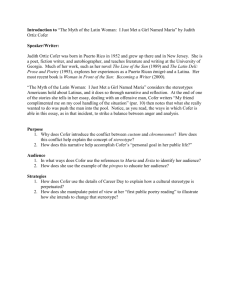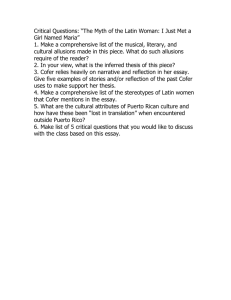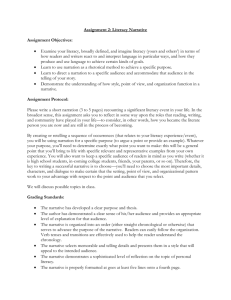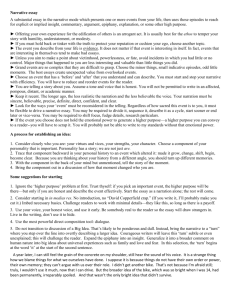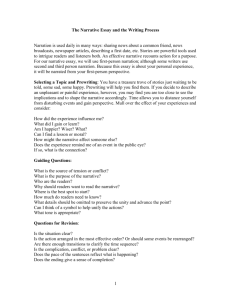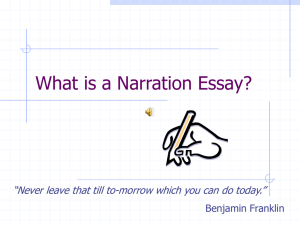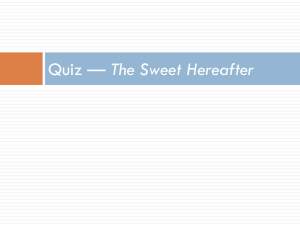Narration & Description - Wiki-cik
advertisement
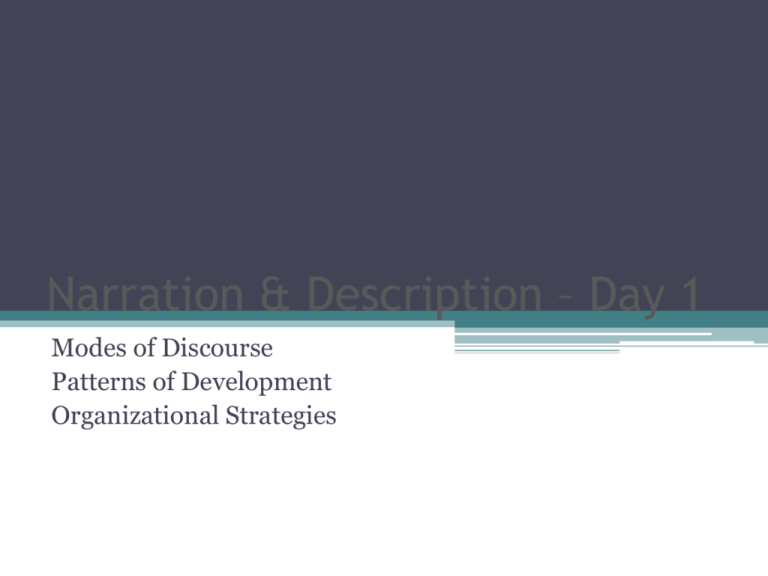
Narration & Description – Day 1 Modes of Discourse Patterns of Development Organizational Strategies When you come in… • What is your story? ▫ Write down several important events that have occurred in your life. ▫ How have those events shaped the person you are today? Narration & Description Background • Narration – telling a story to make a point • Description – evoking the senses to create a picture • BEST when used together for writing a detailed account of some memorable experience ▫ First trip alone ▫ Last-minute political victory ▫ Picnic in some special place Narration & Description Purpose • Introduce or illustrate a complicated subject ▫ Often used to support some other strategy such as causal analysis or argument • Analyze an issue or theme ▫ Example: new awareness of patriotism because of travel in a foreign country Narrative purpose (what happened) and descriptive purpose (what it felt like) linked to other purposes Could explain what caused new awareness (why it happened) or to argue that everyone needs such awareness (why everyone should reach the same conclusions) • Report actions and describe feelings ▫ Autobiography, history, fiction (most common) Narration & Description Audience • Consider ▫ How much do I tell my audience? (narration) Personal experience – few people will know it before you tell it Add or delete material to fit occasion ▫ How much do I show my audience? (description) Unusual subject – include a lot of info, especially if it’s technical New images & insights that create a fresh vision of the subject Narration & Description Strategies • Beginning ▫ Experiences and an essay about the experience are NOT the same Memory will be disorganized and poorly defined ▫ Experience to essay Locate the central conflict Between writer & himself Between writer & others Between writer & environment Narration & Description Strategies (cont’d) • After identifying the conflict ▫ Arrange action so readers know How conflict started How it developed, and How it was resolved. ▫ Types of arrangement (choose pattern according to purpose) Simple chronological order (1, 2, 3, 4, …) Angelou’s “My Name is Margaret” – describes an evolution of events leading up to the broken china Think of a movie that is told in chronological order… Start in the middle or near the end (4, … 1, 2, 3) Williams’ “The Village Watchman” – describes impact of social stigma What about Seven Pounds starring Will Smith – begins at the end then winds its way back Narration & Description Strategies (cont’d) • After identifying the conflict & deciding the plot sequence Establish pace – the speed at which the writer recounts events Quick – omit details, compress time, summarize experience Slow & careful – include every detail, expand on time, present the situation as a fully realized scene Select details – make scenes and summaries effective Special details that satisfy the needs of readers and further your purpose Objective or technical to help reader understand Subjective or impressionistic to appeal to readers’ senses Present details so they form a figurative image or create dominant impression Narration & Description Strategies (cont’d) • In order to identify the conflict, decide the plot sequence, vary the pace, and select details Determine point of view “I” OR “he” or “she” Choose position – how close do you want to be to the action in time and space ▫ Involved in action ▫ View it as an observer ▫ Tell as events are happening or many years after they’ve taken place Narration & Description Points to Remember 1. Focus your narrative on the “story” in your story – that is, focus on the conflict that defines the plot. 2. Vary the pace of your narrative so that you can summarize some events quickly and render others as fully realized scenes. 3. Supply evocative details to help your readers experience the dramatic development of your narrative. 4. Establish a consistent point of view so that your readers know how you have positioned yourself in your story. 5. Represent the events in your narrative so that your story makes its point. In this excerpt from her graphic novel Persepolis: The Story of a Childhood (2003), Marjane Satrapi recounts the reaction of young schoolgirls to the law requiring them to wear “the veil.” Some argue that the veil debases and even erases female identity. Others argue that it provides women with safety and secret power. How do the characters in Satrapi’s narrative feel about this regulation? Defend my claim… • It is the responsibility of parents to indoctrinate their children into the beliefs and views of their culture. • One paragraph, 8.2 format (may use a concrete example instead of a quote). ▫ ▫ ▫ ▫ ▫ ▫ Topic Sentence/Thesis Concrete Detail Commentary x 2 Concrete Detail Commentary x 2 Transition/Conclusion BRING YOUR BOOK TOMORROW! Narration & Description – Day 2 Modes of Discourse Patterns of Development Organizational Strategies Narration & Description Points to Remember 1. Focus your narrative on the “story” in your story – that is, focus on the conflict that defines the plot. 2. Vary the pace of your narrative so that you can summarize some events quickly and render others as fully realized scenes. 3. Supply evocative details to help your readers experience the dramatic development of your narrative. 4. Establish a consistent point of view so that your readers know how you have positioned yourself in your story. 5. Represent the events in your narrative so that your story makes its point. “Maria” from West Side Story • Movie Summary: West Side Story is the award winning adaptation of the classic romantic tragedy, Romeo and Juliet. The feuding families become two warring New York City gangs- the white Jets led by Riff and the Puerto Rican Sharks, led by Bernardo. Their hatred escalates to a point where neither can coexist with any form of understanding. But when Riff's best friend (and former Jet) Tony and Bernardo's younger sister Maria meet at a dance, no one can do anything to stop their love. Maria and Tony begin meeting in secret, planning to run away. Then the Sharks and Jets plan a rumble under the highway - whoever wins gains control of the streets. Maria sends Tony to stop it, hoping it can end the violence. It goes terribly wrong, and before the lovers know what's happened, tragedy strikes and doesn't stop until the climatic and heartbreaking ending. • Scene Set-up: Tony and Maria have just met at a dance. Bernardo, Maria’s brother, orders Maria to go home and tells Tony to stay away from his sister. Tony leaves in a happy daze. • Watch scene from movie. Read Judith Ortiz Cofer’s “The Myth of the Latin Woman: I Just Met a Girl Named Maria” Purpose 1. Why does Cofer introduce the conflict between custom and chromosomes? How does this conflict help explain the concept of stereotype? 2. How does this narrative help accomplish Cofer’s “personal goal in her public life?” Audience 1. In what ways does Cofer use the references to Maria and Evita to identify her audience? 2. How does she use the example of the piropos to educate her audience? Strategies 1. How does Cofere use the details of Career Day to explain how a cultural stereotype is perpetuated? 2. How does she manipulate point of view at her “first public poetry reading” to illustrate how she intends to change that stereotype? Narration & Description – Day 3 Modes of Discourse Patterns of Development Organizational Strategies When you come in… • Get out your computer. • Turn in your answers to the questions about Cofer’s “The Myth of the Latin Woman…” • Discuss with the people at your table Cofer’s story. ▫ What (if any) new understanding did you have after reading this story? ▫ What message about a person’s identity does she convey? Discuss Judith Ortiz Cofer’s “The Myth of the Latin Woman: I Just Met a Girl Named Maria” Purpose 1. Why does Cofer introduce the conflict between custom and chromosomes? How does this conflict help explain the concept of stereotype? 2. How does this narrative help accomplish Cofer’s “personal goal in her public life?” Audience 1. In what ways does Cofer use the references to Maria and Evita to identify her audience? 2. How does she use the example of the piropos to educate her audience? Strategies 1. How does Cofer use the details of Career Day to explain how a cultural stereotype is perpetuated? 2. How does she manipulate point of view at her “first public poetry reading” to illustrate how she intends to change that stereotype? OERs • Answer the question. • Support your answer with direct, textual evidence. • HALT! Answer the question and support it with details from the text. • What does Judith Ortiz Cofer learn from her encounter with the man who sang to her in the hotel? • What is Cofer’s primary goal in writing “The Myth of the Latin Woman…”? • How did Cofer change throughout the narrative? (You must have two quotes from the text.) Narration & Description – Days 5 & 6 Modes of Discourse Patterns of Development Organizational Strategies Final TAKS Push • • • • Writing Prompt – View Range Finders Score your own Essay Beth’s survey It’s Thematically Linked!
